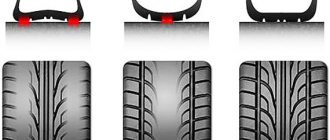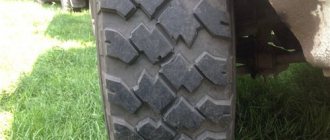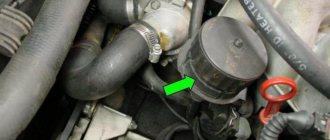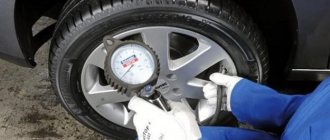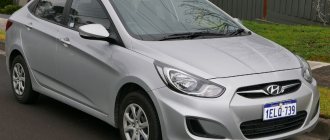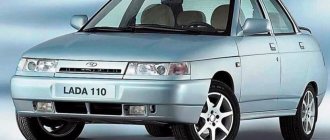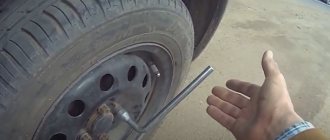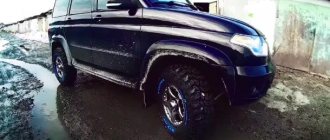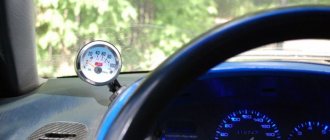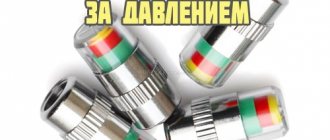Incredibly, such a simple tire parameter as pressure hides many of the vehicle’s performance characteristics. For example, accelerated tire wear, increased fuel consumption, poor directional stability and additional load on the suspension - all this depends on the amount of air in the wheel. Every motorist should know how to check tire pressure and how often to inspect the wheels. Firstly, these are traffic safety conditions. Secondly, the rule applies: caring for technology saves your personal budget.
How is tire pressure measured?
In our country and a number of others, pressure is usually measured in BARs (atmospheres). 1 atm.=1 kgf/cm2. To be extremely precise, 1 atmosphere is equal to 1.0133 bar, but such precision is not needed, it will be concealed by the readings of the pressure gauge, the error of which can reach 2%.
The standard that is common in the USA is PSI (pounds per square inch). To convert PSI to the atmospheres we are familiar with, this value must be divided by 14.5.
Below is a table of approximate ratios of values.
Pressure Standards
| BAR | PSI |
| 1.8 | 26 |
| 1.9 | 28 |
| 2.0 | 29 |
| 2.1 | 30 |
| 2.2 | 32 |
| 2.3 | 33 |
| 2.4 | 35 |
| 2.5 | 36 |
| 2.6 | 38 |
| 2.7 | 39 |
| 2.8 | 41 |
| 2.9 | 42 |
| 3.0 | 44 |
What is it measured in?
In Russia and in the countries of the former CIS, it is customary to measure pressure in kgf/sq.cm, which is equal to 1 atm. (atmosphere). Another system is used by American car manufacturers: psi or lbs (pounds of force applied per square inch). To indicate the maximum permissible density indicators, such a physical quantity as Kilopascals –1 kPa = 6.895 psi is also used. The closest value to such an indicator as the atmosphere is Bar - 1 bar = 0.98 atm.
Comparison of pressure units:
1 psi = 0.068 atm;
1 atm = 14.696 psi;
1 atm = 101.348 kPa;
1 bar = 0.98 atm.
As a rule, household devices for measuring tire pressure are equipped with a scale with names such as: kg/cm2, bar, atm.
How and what to measure
As you drive, the tire rubs against the road surface and the pressure level increases. Heating occurs and the volume of gases inside the tire increases, so in order to correctly measure the level in the tires, the air must cool down. Normal indicators are determined on “cold” tires.
To check and adjust the air density in tires, a special measuring device is used - a pressure gauge. Quite often this device comes complete with a compressor. The choice of measuring devices on the auto goods market is huge and includes from the most budget to innovative models:
- Pointers are simple mechanical spring-type devices. Error up to 0.1 atmospheres. The best models have a clearly readable scale and a mechanism to relieve excess pressure.
- Rack and pinion - with a coil spring and a retractable aluminum rod. The main advantage of this device is its compactness. A digital (electronic) pressure gauge is the most accurate device with an error of ±0.05 units. Problems may arise during severe frosts or shocks. Battery operated.
- TPMS system - individual cap for each wheel. The color of the cover changes depending on the tire pressure. The device cannot be considered highly accurate, but it copes well with the responsibilities of an indicator.
- Cap sensors with an electronic indicator are another modern, expensive device. Miniature keys are installed instead of standard plugs. The device contains a special chip inside that sends a radio signal to an external sensor. The device is powered from the cigarette lighter.
Today, most new cars are equipped with on-board sensors with temperature and pressure indicators. Air level and temperature data are displayed on the vehicle's touch screen. The on-board system itself warns the driver about the need to inflate or lower the tire.
Where does the manufacturer indicate pressure standards?
Optimal pressure indicators are individual characteristics recommended by the car manufacturer. This data is located in the accompanying and service documentation, operating instructions and on special labels. The nameplates are located inside the fuel filler flap, in the glove compartment or on the inside of the driver's door pillar. This sticker looks like this:
A number of cars contain recommendations with different pressure indicators for the front and rear wheels. Also, the nameplates contain information about the recommended tire size. Low-profile tires require more careful attention - they have an increased rim diameter and a low sidewall height. The indicators that relate to such wheels are, as a rule, the figures for the maximum permissible density.
TOP 5 analog pressure gauges for cars
Berkut ADG-031 and ADG-032
Models differ in measurement limit: ADG-031 – 2.5 atm, ADG-032 – 4.2 atm. Flexible hose makes measurements easy. Pressure gauges are equipped with fabric covers for storage and transportation.
Thanks to the built-in deflator, it can be used to reduce tire pressure in a controlled manner to increase maneuverability on snowy or sandy roads. The device operates in a wide temperature range from -20 to +50 degrees. Articles for purchase ADG031 and ADG032.
Main characteristics:
- dimensions – 192 x 114 x 36 mm;
- weight – 0.25 kg;
- division price – 0.1 atm ADG-031/ 0.2 atm ADG-032;
- accuracy class – 1.5 ADG-031/ 1 ADG-032.
1
- Pros:
- accuracy;
- reliable contact;
- deflator valve;
- flexible connection;
- case included.
- Minuses:
- no memory of readings;
- high price.
Heyner 564200
The Heyner 564200 is a compact steel pressure gauge designed to measure tire pressure up to 4.5 bar. The scale has good graduation quality and contrast. For protection, the device has a rubber cover, stylized as a wheel. Equipped with a rotating clamping head. Able to remember the last readings received. It has good accuracy in a wide temperature range from -20 to +50 degrees. Heyner pressure gauge can be found under article number Heyner 564-200
Main characteristics:
- dimensions – 100 x 45 x 30 mm;
- weight – 0.1 kg;
- range – 4.5 bar;
- division price – 0.1 bar;
- accuracy class – 1.
2
- Pros:
- accuracy;
- protected housing;
- memory;
- affordable price.
- Minuses:
- no case included;
- without deflator.
JONNESWAY AG010042
JONNESWAY AG010042 is a compact pressure meter in a metal housing, supplied in a translucent plastic case. Allows you to measure pressure up to 4.2 bar, conveniently connects with a clamp, and can remember the received readings. There is a button on the case to reset the readings. When purchasing AG-010042, you should pay attention to the scale, as there are versions calibrated only in PSI.
Main characteristics:
- dimensions – 95 x 52 x 29 mm;
- weight – 0.11 kg;
- range – 4.2 bar;
- division price – 0.2 bar;
- accuracy class – 1.
3
- Pros:
- accurate readings;
- durable body;
- case included.
- Minuses:
- no head rotation;
- without deflator;
- high price.
SKYWAY S07701005
SKYWAY S07701005 is a universal tire pressure gauge that is suitable for measuring the pressure in tires of passenger cars and light commercial vehicles. The device body is metal, with additional rubber protection. The dial scale is marked up to 7 atmospheres. The connection to the nipple is a threaded head on a flexible hose. There is a memory, there is a button on the case that is responsible for resetting the last readings received. Article for purchasing the SKYWAY pressure gauge S07701005.
Main characteristics:
- dimensions – 130 x 30 x 12 mm;
- weight – 0.14 kg;
- range – 7 atmospheres;
- division price - 0.2 atmospheres;
- accuracy class – 1.
4
- Pros:
- security;
- convenient connection.
- Minuses:
- the range is excessive for low-pressure passenger wheels;
- no scale backlight.
Vympel MN-01
Vympel MN-01 is a budget pressure gauge with a metal case and an easy-to-read scale with markings up to 7.5 bar. Connects with a clamp, the head is fixed. It has a memory function for the last readings, provided by a mechanical lock (reset with a button). Pennant MH01 is supplied in a case for storage and transportation. Users noticed an overestimation of the indicator by 0.2 atm.
Main characteristics:
- dimensions – 130 x 60 x 40 mm (packed);
- weight – 0.13 kg;
- range – 7.5 bar;
- division price – 0.1 bar;
- accuracy class – 1.5.
5
- Pros:
- low price;
- case included;
- memory.
- Minuses:
- the range is excessive for low pressure wheels;
- average accuracy.
How to measure blood pressure: the correct sequence
Alas, even the majority of experienced drivers completely ignore the procedure for monitoring the tire pressure of a car, considering this procedure absolutely useless. Checking tire pressure is carried out using a pressure gauge, which can be integral with the pump, or be a separate element. Do not forget that the error of any pressure gauge is usually 0.2 kgf/cm2.
Pressure measurement sequence:
- It is necessary to reset the pressure gauge readings.
- Unscrew the safety cap (if equipped) from the wheel nipple.
- Connect the pressure gauge to the nipple and press it lightly to release air from the chamber.
- Wait until the instrument needle stops.
This procedure must be performed monthly during regular use of the vehicle. The measurement should be taken before leaving, when the tires are not yet warmed up. This is necessary to accurately determine the readings, since after the tires warm up, the air pressure inside them increases. This is often caused by dynamic driving with constant changes in speed and sudden braking. For this reason, it is ideal to take measurements before driving, when the tires on the car have not yet warmed up.
How often do you check tire pressure?
Statistics simply show that the vast majority of cars on our roads have inadequate parameters. Although driving around the city in this situation does not pose a big threat, driving off-road already poses a big risk, especially in the hot summer.
rice. It is necessary to check your blood pressure at least once a month.
To avoid troubles on the road, follow these guidelines:
- Monitor atmospheric levels at least once a month and before each long journey.
- Only competent pumping ensures optimal working conditions.
- Too low or high an indicator will shorten the service life of products and increase gasoline consumption.
If it’s difficult for you to independently monitor the condition of your wheels, inflate them, and maintain them, calling a 24-hour mobile tire service would be an excellent solution.
How does a tire pressure sensor work?
operating principle of tire
pressure sensors is to use the ABS system. It is installed directly at the factory - the system transmits data to the on-board computer, which processes the information and signals violations. In essence, this is not a sensor, but an indirect control system, but in practice few people make strict distinctions.
But direct control systems are precisely sensors. The sensors measure the pressure in the tires on which they are located. They take readings and signal deviations to the driver. It all depends on the type of device - some simply change color, others transmit information to a special screen in the car.
Types of sensors
There are two main types of control devices - mechanical and electronic.
Mechanical ones are caps that are installed on the pumping valves and change color depending on the intra-chamber pressure. It squeezes out an indicator of the “right” color.
This device is low cost and easy to operate. But it has many more disadvantages.
For example, these:
- measurements cannot be taken while driving;
- the accuracy of the readings is very low;
- short service life (usually up to six months, sometimes a little longer);
- caps are often stolen.
Electronic tire pressure sensor
Electronic sensors are more convenient, multifunctional and accurate. They are mounted on the wheel and transmit information to the screen in the cabin, displaying it in graphical and digital form. While driving, such a sensor records the pressure level inside the tire, the temperature inside the tire, and the wheel rotation speed.
Installing pressure sensors on cars
Statistics confirm that most motorists do not check whether their tires are properly inflated before driving. As a result, the risk of road accidents increases. At the same time, about 40% of drivers measure their blood pressure once every 12 months.
If you do not want to regularly measure with a pressure gauge, you can install pressure sensors. This is a new option that will help reduce the risk of an emergency. The use of sensors will increase the service life of tires.
Today, you can purchase different models of sensors in specialized stores. There are external devices; they are installed in place of the spools. Their work is based on the air blocking mechanism in the wheel.
Some sensors that can be bought at a car store show changes in tire pressure as a result of natural fluctuations. However, such devices have a disadvantage: they are not protected from mechanical damage, they can be stolen, and no special devices are required.
We recommend
“Air pressure in wheels: what should it be and how to measure it” Read more
Sensors installed inside are more reliable, since vandals will not be able to reach them. Such devices are located inside the tire. If they want to steal them, they will have to twist the wheel completely. However, the cost of such sensors is quite high.
Differences between sensors may also be in the way pressure is determined. Based on this, there are several types of devices.
The most budget option is mechanical sensors installed externally. They have a simple design. The operating principle is as follows: the cap is shifted under air pressure in the wheels from the green area of normal pressure to the red area of low pressure. Such devices do not have chips and are not capable of transmitting data to the control panel. Therefore, you can find out the resulting value only visually.
Electronic sensors are more complex, but they are more convenient to use. They contain a chip that transmits data to the display. There are 2 positions: green - the pressure is normal, red - the indicator is higher or lower than optimal.
Internal electronic sensors are the most complex, but the cost of such devices is higher. They consist of an internal part, which is installed in the tires, and an external part - a small computer. With its help, data is collected from sensors and the information received is analyzed. Then the display shows the tire temperature, rotation speed and other parameters. The most modern sensor models are capable of transmitting information to the car owner’s phone using special software.
You can install simple sensors with your own hands, the main thing is to study the chosen model and how it works. On some vehicles, such devices are installed at the factory. However, not all cars are equipped with them.
When to check your blood pressure
The tire pressure of the car is checked every time the car is parked for a long time. For continuous use, the frequency is once every two weeks.
Unscheduled measurements are taken:
- before a long trip;
- in case of sudden thaw or frost;
- 100 km after any installation/removal of tires.
Unlike European manufacturers, the Japanese recommend adjusting the pressure depending on the make of the car and its operating conditions, for example, before loading the car more. A visual inspection is performed before each trip. If the tires go flat, do not delay visiting the tire shop and be sure to check the air density in the spare wheel.
When the tire is poorly inflated
If the tire is insufficiently inflated, the pressure of the wheel on the road is uneven, the quality (spot) of adhesion to the road surface decreases, and the tire itself is subject to premature wear. In addition, due to low rolling, fuel consumption increases.
Low tire pressure can be easily determined by its deformation, poor handling, and the car will pull towards the flat tire. In this case, there is a high probability of the frame breaking, damage to the cord threads, which will cause the tire to become unusable. To put it in the language of motorists, it will chew rubber.
If the wheel is overinflated
An overinflated tire becomes too hard. It rolls easily, but like a flat tire, it has insufficient grip on the road, and this is fraught with accidents. The car will jump excessively, increasing the load on the body and suspension elements, and if it gets into a hole, the tire may simply burst.
When the machine is heavily loaded, it is not recommended to greatly increase the tire pressure, since all of the above risks can only intensify.
Additional points
- The indicator indicated by the manufacturer is not always 100% correct. So, if your car was created for use in mild climates and driving on smooth roads, and you operate it in places with temperature changes and a lot of potholes, you will need to adjust the pressure to achieve driving comfort.
- Can a tire burst if the maximum value specified by the manufacturer is exceeded? No, because this value is for a fully loaded machine. However, if the tires are inflated too much, any defect in the road surface may cause a driving accident.
- Adjust the value depending on the load level of the machine. If you are carrying additional cargo in the trunk or roof, inflate the rear tires, especially if you have a long trip ahead. Remember to measure and change the pressure again after removing the weight.
- Experienced drivers claim that they can determine the indicator “by eye”. It is not recommended to rely on human senses, as it is almost impossible for even a master to understand the difference between 10 and 20 PSI. Use a pressure gauge - it's fast, convenient and inexpensive.
Measuring the tire pressure of a car is a simple task. Remember that a safe and comfortable ride is only possible with optimal performance. Do not neglect the control procedure.
When and how to replace the timing chain - step-by-step instructions
How and when to change the valve of the VAZ 2105-07 stove
What should the pressure be?
The recommended tire pressure is usually determined by the vehicle manufacturer. There are a number of other factors, such as:
- vehicle's own weight;
- disc diameters;
- tire indices and markings.
You can find out what tire pressure should be in your tires from signs placed on the door pillar, gas filler flap or glove compartment. It is recommended to take measurements only when the tire is cold, since as it moves it heats up and the air inside expands, which gives a serious error in measurements.
For greater clarity, below is a table of tire pressures by car brand.
The specified values are recommended by car manufacturers.
How to find out the tire pressure of your car
A car is a technically complex device. The operation of all components is precisely calculated by engineers. In order for the car to meet factory specifications, the automaker informs the owner that the operating parameters are being observed. One of these parameters is “tire pressure”. Requirements for the volume of pressure in the wheels are published in the operating instructions.
In addition, the information is duplicated by a sticker (nameplate) on the pillar in the driver's doorway. The plate indicates: tire size, wheel dimensions and air pressure. Sometimes, the sticker is located in the passenger door frame or on the inside of the gas filler flap. The unit of measurement for pressure can be indicated in bars (Bar), kilopascals (kPa) or pounds (PSi).
Table of tire pressure standards for all car brands
Car make / Dimensions / Pressure (front/rear)
| vaz/lada | ||
| 2104 | 165/80 R13 | 1.6/2.1 |
| 175/70 R13 | 1.6/2.2 | |
| 2106 | 165/80 R13 | 1.6/1.9 |
| 175/70 R13 | 1.7/2.0 | |
| 165/70 R13 | 1.8/2.1 | |
| 2107 | 165/80 R13 | 1.6/1.9 |
| 175/70 R13 | 1.7/2.0 | |
| 2109/21099 | 165/70 R13 | 1.9/1.9 |
| 175/70 R13 | 1.9/1.9 | |
| 155/80 R13 | 1.9/1.9 | |
| 2110/2111/2112 | 175/70 R13 | 1.9/1.9 |
| 175/65 R14 | 1.8/1.8 | |
| 185/60 R14 | 1.8/1.8 | |
| 2114/2115 | 165/70 R13 | 1.9/1.9 |
| 175/70 R13 | 1.9/1.9 | |
| vesta | 185/65 R15 | 2.1/2.1 |
| 195/55 R16 | 2.1/2.1 | |
| granta | 175/70 R13 | 1.9/2.1 |
| 175/65 R14 | 2.0/2.2 | |
| Granta liftback | 175/65 R14 | 2.0/2.2 |
| 185/60 R14 | 2.0/2.2 | |
| 185/55 R15 | 2.0/2.2 | |
| viburnum (kalina) | 175/70 R13 | 1.9/1.9 |
| Kalina station wagon/hatchback | 185/60 R14 | 1.9/1.9 |
| priora | 175/70 R13 | 1.9/1.9 |
| 185/60 R14 | 1.9/1.9 | |
| Largus/Largus cross | 185/70 R14 | 2.4/2.6 |
| 185/65 R15 | 2.4/2.6 | |
| Niva | ||
| 2121/21213/21214/2131 | 175/80 R16 | 2.1/1.9 |
| 185/75 R16 | 2.1/2.0 | |
| gas | ||
| 3110/31105 | 195/65 R15 | 2.0/2.1 |
| 3307/3309 | 8.25R20 | 4.5/6.3 |
| 3308 | 12.00R18 | 3.5/4.5 |
| 53 | 8.25R20 | 4.0/6.3 |
| 66 | 8.00R18 | 2.8/2.8 |
| gazelle | ||
| 2705 (business) | 185/75 R16 | 3.0/3.0 |
| 3302 (cargo) | 185/75 R16 | 3.0/3.0 |
| next | 185/75 R16 | 3.6/2.9 |
| passenger | 185/75 R16 | 3.0/3.0 |
| sable | 215/65 R16 | 2.7/2.7 |
| sable 2752 | 185/75 R16 | 3.3/3.9 |
| Valdai | 215/75 R17 | 5.4/6.3 |
| lawn next | 185/75 R16 | 3.3/3.9 |
| zil | ||
| 130/131 | 9.00R20 | 4.5/6.0 |
| 5301 (bull) | 225/75 R16 | 5.0/6.0 |
| UAZ | ||
| 469 | 235/70R16 | 2.0/2.3 |
| patriot | 225/75R16 | 2.0/2.4 |
| 235/70R16 | 1.9/2.2 | |
| 245/70R16 | 1.8/2.1 | |
| 245/60R18 | 1.8/2.0 | |
| loaf | 225/75R16 | 2.0/2.3 |
| hunter | 225/75R16 | 2.0/2.3 |
| 235/70R16 | 2.1/2.4 | |
| KAMAZ | ||
| 4308 | 245/70R19.5 | 4.8/4.8 |
| 4310 | 245/70R19.5 | 4.8/4.8 |
| 43118 | 425/85R21 | 5.6/5.6 |
| other | ||
| maz | 235/75R17.5 | 6.5/7.3 |
| oka | 135/80R12 | 1.8/1.8 |
| Ural 4320 | 390/95R20 | 4.0/4.0 |
| groove 32053 | 245/70R19.5 | 5.6/4.6 |
| audi | ||
| a4 | 225/50R17 | 2.3/2.3 |
| 235/40R18 | 2.5/2.5 | |
| 245/45R17 | 2.2/2.1 | |
| q5 | 235/65R17 | 2.1/2.1 |
| 235/60R18 | 2.1/2.1 | |
| 235/55R19 | 2.1/2.1 | |
| 255/45R20 | 2.1/2.1 | |
| bmw | ||
| x5 | 235/65R17 | 2.2/2.2 |
| 255/55R18 | 2.2/2.2 | |
| 255/50R19 | 2.1/2.5 | |
| e39 | 225/60R15 | 2.0/2.2 |
| 205/65R15 | 2.2/2.4 | |
| 235/40R18 | 1.9/2.3 | |
| 265/35R18 | 2.3/2.7 | |
| 225/55R16 | 2.3/2.7 | |
| 235/45R17 | 2.5/2.7 | |
| x1 | 225/50R17 | 2.2/2.7 |
| 225/45R18 | 2.5/2.7 | |
| daewoo | ||
| matiz | 145/70R13 | 1.9/1.9 |
| 155/65R13 | 1.9/1.9 | |
| nexia | 175/70R13 | 2.0/2.1 |
| 185/60R14 | 2.2/2.4 | |
| dodge | ||
| caliber | 215/60R17 | 2.2/2.2 |
| 215/55R18 | 2.2/2.2 | |
| 225/45R19 | 2.2/2.2 | |
| caravan | 215/65R15 | 2.2/2.3 |
| ford | ||
| focus 3 | 195/65R15 | 2.1/2.1 |
| 205/55R16 | 2.1/2.1 | |
| 205/50R17 | 2.1/2.1 | |
| 225/40R18 | 2.1/2.1 | |
| kuga | 235/55R17 | 2.4/2.4 |
| 235/50R18 | 2.3/2.3 | |
| 235/45R19 | 2.3/2.3 | |
| mondeo 4 | 185/65R14 | 2.1/2.1 |
| 195/60R14 | 2.1/2.1 | |
| 205/55R15 | 2.1/2.1 | |
| transit | 195/70R15 | 3.4/2.7 |
| 195/65R16 | 3.7/4.0 | |
| 205/75R16 | 3.0/3.9 | |
| 215/75R16 | 3.0/4.0 | |
| focus 1 | 185/65R14 | 2.2/2.2 |
| 195/55R15 | 2.0/2.0 | |
| 205/50R16 | 2.2/2.2 | |
| 185/60R15 | 2.2/2.2 | |
| 215/40R17 | 2.2/2.2 | |
| focus 2 | 195/65R15 | 2.1/2.1 |
| 205/55R16 | 2.1/2.1 | |
| 225/40R18 | 2.1/2.1 | |
| fusion | 195/60R15 | 2.4/2.2 |
| 195/55R16 | 2.4/2.2 | |
| Explorer 5 | 235/75R15 | 2.1/2.4 |
| 225/70R15 | 2.1/2.4 | |
| fiat (fiat) | ||
| ducato | 195/70R15 | 4.1/4.5 |
| 205/70R15 | 4.1/4.5 | |
| 215/75R16 | 4.5/4.5 | |
| Jeep (jeep) | ||
| Grand Cherokee | 225/75R16 | 2.3/2.3 |
| 235/65R17 | 2.3/2.3 | |
| 235/70R16 | 2.3/2.3 | |
| 245/60R18 | 2.3/2.3 | |
| Hyundai | ||
| 78 | 175/60R14 | 2.3/2.3 |
| 175/50R15 | 2.3/2.3 | |
| ix35 | 215/70R16 | 2.3/2.3 |
| 225/60R17 | 2.3/2.3 | |
| accent | 155/80R13 | 2.1/2.1 |
| 185/60R14 | 2.1/2.1 | |
| 175/70R14 | 2.1/2.1 | |
| 195/55R15 | 2.1/2.1 | |
| Creta (Greta) | 215/65R16 | 2.3/2.3 |
| porter 2 (portrer) | 185/80R14 | 3.0/4.5 |
| solaris | 185/65R15 | 2.2/2.2 |
| 195/55R16 | 2.2/2.2 | |
| tucson | 215/65R16 | 2.1/2.1 |
| 235/60R16 | 2.1/2.1 | |
| getz | 155/80R13 | 2.1/2.1 |
| 175/65R14 | 2.1/2.1 | |
| 185/55R15 | 2.1/2.1 | |
| santa fe | 215/70R15 | 2.1/2.1 |
| 225/70R16 | 2.1/2.1 | |
| 235/70R16 | 2.1/2.1 | |
| 235/60R18 | 2.1/2.1 | |
| Chery | ||
| Cherie Tiggo (tiggo) | 225/65R17 | 2.3/2.3 |
| Chevrolet | ||
| aveo | 155/80R13 | 2.1/2.1 |
| 185/60R14 | 2.1/2.1 | |
| 195/65R15 | 2.5/2.5 | |
| 205/55R16 | 2.5/2.5 | |
| cobalt | 185/75R14 | 2.5/2.5 |
| 195/65R15 | 2.4/2.4 | |
| lanos | 175/70R13 | 2.2/2.2 |
| 185/60R14 | 2.2/2.2 | |
| Lacetti | 195/55R15 | 2.3/2.3 |
| Chevy Niva | 205/65R15 | 2.1/2.1 |
| 205/70R15 | 2.1/2.1 | |
| 215/65R16 | 2.2/2.2 | |
| captiva | 215/70R16 | 2.1/2.1 |
| 235/55R18 | 2.1/2.1 | |
| Cruze | 205/60R16 | 2.2/2.2 |
| 215/55R17 | 2.2/2.2 | |
| Kia | ||
| picanto | 155/70R13 | 2.1/2.1 |
| 165/60R14 | 2.1/2.1 | |
| 175/50R15 | 2.1/2.1 | |
| rio | 155/80R13 | 2.1/2.1 |
| 175/70R13 | 2.1/2.1 | |
| 175/70R14 | 2.1/2.1 | |
| 185/65R15 | 2.1/2.1 | |
| 195/55R15 | 2.2/2.2 | |
| 195/55R16 | 2.2/2.2 | |
| seed | 185/65R15 | 2.2/2.2 |
| 225/45R17 | 2.2/2.2 | |
| sorento | 225/75R16 | 2.5/2.5 |
| 245/70R16 | 2.5/2.5 | |
| 235/65R17 | 2.2/2.2 | |
| 235/60R18 | 2.3/2.3 | |
| sportage (3, 4, 2016) | 205/70R15 | 1.8/1.8 |
| 215/65R16 | 2.1/2.1 | |
| 235/60R16 | 2.1/2.1 | |
| 215/70R16 | 2.3/2.3 | |
| 225/60R17 | 2.3/2.3 | |
| cerato | 195/60R15 | 2.1/2.1 |
| 205/50R16 | 2.1/2.1 | |
| Lexus (Lexus) | ||
| 570 | 285/60R18 | 2.3/2.6 |
| 285/50R20 | 2.3/2.6 | |
| rx350 | 225/60R17 | 2.1/2.1 |
| 235/55R18 | 2.2/2.2 | |
| 235/60R18 | 2.3/2.3 | |
| 235/55R19 | 2.3/2.3 | |
| Mitsubishi (Mitsubishi) | ||
| Lancer 10 (9) | 195/60R15 | 2.2/2.1 |
| 195/50R16 | 2.3/2.1 | |
| 235/45R17 | 2.2/1.9 | |
| 205/60R16 | 2.2/2.2 | |
| 215/45R18 | 2.2/2.2 | |
| Outlander | 215/55R16 | 2.1/2.0 |
| 215/70R16 | 2.2/2.2 | |
| 215/55R17 | 2.2/2.2 | |
| 225/55R18 | 2.2/2.2 | |
| Pajero 4 (pajero) | 265/65R17 | 2.2/2.4 |
| 265/60R18 | 2.2/2.4 | |
| Mercedes (Mercedes) | ||
| sprinter | 225/70R15 | 2.8/4.0 |
| Mazda (Mazda) | ||
| 3 | 195/65R15 | 2.2/2.2 |
| 205/60R15 | 2.5/2.3 | |
| 205/55R16 | 2.2/2.2 | |
| 6 | 195/65R15 | 2.2/2.2 |
| 195/65R16 | 2.2/2.2 | |
| 205/55R16 | 2.2/2.2 | |
| 215/45R17 | 2.2/2.2 | |
| 215/50R17 | 2.2/2.2 | |
| 215/45R18 | 2.2/2.2 | |
| cx 5 | 225/65R17 | 2.3/2.3 |
| 225/55R19 | 2.5/2.5 | |
| cx 7 | 235/60R18 | 2.2/2.2 |
| 235/55R19 | 2.2/2.2 | |
| Nissan | ||
| Qashqai | 215/65R16 | 2.3/2.3 |
| 215/60R17 | 2.3/2.3 | |
| 215/55R18 | 2.3/2.3 | |
| almera/classic | 185/65R15 | 2.0/2.0 |
| 195/60R15 | 2.0/2.0 | |
| 195/55R16 | 2.0/2.0 | |
| laptop (note) | 185/65R15 | 2.3/2.1 |
| 175/65R15 | 2.3/2.1 | |
| 185/55R16 | 2.3/2.1 | |
| teana | 205/65R16 | 2.2/2.0 |
| 215/55R17 | 2.2/2.0 | |
| tiida | 185/65R15 | 2.3/2.1 |
| 195/65R16 | 2.3/2.1 | |
| x trail (x-trail) | 215/70R15 | 2.2/2.2 |
| 215/65R16 | 2.2/2.2 | |
| x trail t31 | 215/65R16 | 2.3/2.1 |
| 225/60R17 | 2.3/2.1 | |
| 225/55R18 | 2.3/2.1 | |
| Opel (Opel) | ||
| astra jh (astra) | 225/55R17 | 2.2/2.2 |
| 235/55R17 | 2.2/2.2 | |
| 235/50R18 | 2.2/2.2 | |
| 245/45R18 | 2.2/2.2 | |
| 235/45R19 | 2.2/2.2 | |
| 245/40R20 | 2.2/2.2 | |
| corsa | 185/70R14 | 2.0/1.8 |
| 185/65R15 | 2.0/1.8 | |
| 195/60R15 | 2.0/1.8 | |
| 195/55R16 | 2.0/1.8 | |
| 215/45R17 | 2.0/1.8 | |
| Peugeot | ||
| 206 | 165/70R13 | 2.2/2.2 |
| 175/65R14 | 2.4/2.4 | |
| 185/55R15 | 2.3/2.3 | |
| 205/45R16 | 2.3/2.3 | |
| 307 | 195/65R15 | 2.3/2.3 |
| 205/55R16 | 2.5/2.5 | |
| 205/50R17 | 2.5/2.5 | |
| 308 | 195/65R15 | 2.3/2.3 |
| 205/55R16 | 2.4/2.4 | |
| 215/55R16 | 2.5/2.5 | |
| 225/45R17 | 2.5/2.5 | |
| 225/40R18 | 2.7/2.7 | |
| boxer | 195/70R15 | 4.1/4.5 |
| 205/70R15 | 4.1/4.5 | |
| 205/75R16 | 4.5/4.7 | |
| 215/75R16 | 4.5/4.7 | |
| 215/70R15 | 4.1/4.1 | |
| 215/70R16 | 5.0/5.0 | |
| 225/75R16 | 4.6/5.1 | |
| partner | 165/70R14 | 2.4/2.6 |
| 175/65R14 | 2.6/2.6 | |
| 185/65R15 | 2.0/2.2 | |
| 195/65R15 | 2.3/2.3 | |
| Renault (Renault) | ||
| sandero | 185/65R15 | 2.2/2.2 |
| 195/55R16 | 2.2/2.2 | |
| simbol | 175/70R13 | 1.9/2.1 |
| 175/65R14 | 1.9/2.1 | |
| 185/60R14 | 2.2/2.4 | |
| 185/55R15 | 2.3/2.5 | |
| duster | 215/65R16 | 2.0/2.0 |
| logan | 165/80R14 | 2.0/2.0 |
| 185/65R15 | 2.1/2.0 | |
| Megane 2 | 195/65R15 | 2.4/2.0 |
| 205/55R16 | 2.2/2.0 | |
| 205/50R17 | 2.2/2.0 | |
| 205/55R17 | 2.2/2.0 | |
| SsangYong | ||
| Kyron | 225/75R16 | 2.3/2.3 |
| 235/75R16 | 2.1/2.1 | |
| 255/60R18 | 2.1/2.1 | |
| Subaru (subaru) | ||
| outback | 185/70R14 | 2.2/2.1 |
| 195/60R15 | 2.2/2.1 | |
| 205/50R16 | 2.3/2.2 | |
| 215/60R16 | 2.0/2.0 | |
| 205/55R16 | 2.2/2.2 | |
| 215/45R17 | 2.2/2.2 | |
| 215/50R17 | 2.5/2.4 | |
| 215/55R17 | 2.2/2.0 | |
| 225/60R17 | 2.3/2.2 | |
| Suzuki | ||
| grand vitara | 195/80R15 | 1.8/1.8 |
| 205/75R15 | 1.8/1.8 | |
| 215/65R16 | 1.8/2.1 | |
| 235/60R16 | 1.8/1.8 | |
| 215/70R15 | 2.2/2.2 | |
| 225/65R17 | 2.2/2.2 | |
| Toyota | ||
| rav4 (rav 4) | 215/70R16 | 2.0/2.0 |
| 235/60R16 | 2.0/2.0 | |
| 225/65R17 | 2.2/2.2 | |
| 235/55R18 | 2.2/2.2 | |
| land cruiser prado | 215/80R16 | 2.2/2.2 |
| land cruiser prado | 265/70R16 | 2.6/2.4 |
| 100, 120, 150, 200 | 225/70R17 | 2.4/2.4 |
| 265/65R17 | 2.4/2.4 | |
| auris | 195/65R15 | 2.2/2.2 |
| 205/55R16 | 2.3/2.3 | |
| 225/45R17 | 2.3/2.3 | |
| camry | 205/65R15 | 2.3/2.3 |
| 215/60R16 | 2.1/2.1 | |
| corolla | 155/80R13 | 2.1/2.0 |
| 165/70R14 | 2.2/2.2 | |
| 175/65R14 | 2.2/2.2 | |
| 185/65R14 | 2.2/2.2 | |
| 185/55R15 | 2.2/2.2 | |
| 195/55R15 | 2.2/2.2 | |
| Volkswagen (volkswagen) | ||
| b5, b6 | 195/65R15 | 1.9/1.9 |
| 205/60R15 | 2.4/2.2 | |
| 205/55R16 | 2.0/1.9 | |
| 225/45R17 | 2.3/2.1 | |
| polo sedan (polo) | 195/55R15 | 2.0/1.9 |
| 205/45R16 | 2.3/2.1 | |
| tiguan | 215/65R16 | 2.2/2.2 |
| 215/60R17 | 2.2/2.2 | |
| 235/55R17 | 2.2/2.2 | |
| 235/50R18 | 2.2/2.2 | |
| Tuareg (Tuareg) | 235/65R17 | 2.3/2.5 |
| 255/60R17 | 2.3/2.5 | |
| 255/55R18 | 2.3/2.5 | |
| 265/50R19 | 2.3/2.5 | |
| 275/45R20 | 2.3/2.5 | |
| 275/40R21 | 2.3/2.5 | |
| Volvo (Volvo) | ||
| xc90 | 235/65R17 | 2.2/2.7 |
| 235/60R18 | 2.7/2.7 | |
| 255/50R19 | 2.4/2.4 | |
| 255/45R20 | 2.4/2.4 | |
| Scoda (Skoda) | ||
| Octavia A5 (octavia) | 195/65R15 | 2.2/2.2 |
| 205/60R15 | 2.1/2.2 | |
| 205/55R16 | 2.2/2.2 | |
| 225/45R17 | 2.2/2.2 | |
| Octavia A7 | 195/65R15 | 2.2/2.3 |
| 205/55R16 | 2.1/2.1 | |
| 205/50R17 | 2.1/2.1 | |
| 225/45R17 | 2.1/2.1 | |
| 225/40R18 | 2.0/2.1 | |
| rapid | 185/60R15 | 2.2/2.4 |
| 195/55R15 | 2.2/2.4 | |
| 215/45R16 | 2.2/2.3 | |
| 215/40R17 | 2.2/2.3 | |
| Honda | ||
| CRV | 205/70R15 | 1.8/1.8 |
| 205/65R16 | 1.8/1.8 | |
| 215/65R16 | 2.1/2.0 | |
VAZ: Lada, Niva, Kalina, Granta, Priora, Vesta, Largus
| Model | Type, radius | In front tires (atm/psi) | Rear (atm/psi) |
Ford/Ford: Focus, Mondeo, Fusion
Hyudai/Hyundai: Accent, Creta/Greta, Solaris, Getz, Santa Fe, Tussan, Sonata
| Creta: | 215/65 R16 | 2,3 | 2,3 |
Kia/Kia: Sportage, Rio, Sid, etc.
Instruments for measuring pressure levels
How to check the tire pressure of a car? For this purpose, special devices are used - pressure gauges:
Switch
Mechanical, spring type. Relatively inexpensive, provides readings with an accuracy of 0.1 units
Rack and pinion
Coil spring. Reliable, affordable, easy to use
Digital
With digital screen. A more modern alternative to mechanical devices
Indicator cap
Miniature device for each wheel. Purchased as a set of four. Screws on instead of regular caps, works very clearly, the color of the indicator depends on the tire pressure
External cap sensors
Electronic tire pressure and temperature indicator. Modern high-precision online monitoring device
Important! Pressure measurements are taken before driving in “cold” tires, after several – at least 5, optimally 8 – hours of rest.
Rating of the best pressure gauges for measuring tire pressure
There is a large amount of measuring equipment on the domestic market. But choosing a truly high-quality device is difficult. The further rating is based on customer reviews and popularity in retail outlets.
5th place: Muscle M30
Price from 650 rub. The last place is occupied by a good digital meter of domestic production. Overall a decent model with a comfortable and stylish design. The spool is pressed to a sufficient depth, which allows you to set the actual value inside the wheel without additional manipulations. There is also a tip light.
The disadvantages include sensitivity to shaking and power problems - the batteries quickly die.
Advantages:
- minimum weight;
- compact body.
Flaws:
- batteries run out quickly;
- afraid of excessive shaking.
4th place: Torero
Price from 1000 rub. Next on the list of the best pressure gauges is an electronic model made in a metal case. The stylish design with a pistol grip is complemented by good accuracy in measuring car and other tires.
There is sufficient functionality and reliability here. The program contains three generally accepted gradations.
Advantages:
- durable body;
- there are three gradations;
- holds a charge for a long time.
Flaws:
- high price;
- It is inconvenient to look at the device readings.
3rd place: Heyler Aero Moment Pro
Price from 300 rub. Cheap and cheerful. A basic mechanical meter is not the most accurate, but its reliability and ease of use are excellent. The ergonomics of the unit are represented by an air release valve, a rubberized body and a reliable clamping head. This combination allows the candidate to rise to third place. However, some buyers complain that there is a high probability of buying a fake.
Advantages:
- minimum price tag;
- convenient to use;
- durable body.
Flaws:
- When purchasing, you must check the veracity of the testimony.
2nd place: Daewoo DWM 7
Price from 600 rub. The Korean electronic device is slightly inferior to the leader. Thanks to the high accuracy of the indicators and three gradations of units of measurement, it is possible to obtain accurate data from any wheel. The only complaint from users is that the body is too small - it is inconvenient to hold it with a large hand.
Advantages:
- good accuracy;
- reliable design;
- works in severe frost.
Flaws:
- For a motorist with large hands, it is better to choose a less compact model.
1st place: Berkut Digital
Price from 100 rub.
A version tested by hundreds of users, presented in a user-friendly design. The measuring device has an error of 0.05 At, which is unattainable for its closest analogues. Ease of operation is complemented by economical battery consumption. The only downside is that the display freezes when exposed to the cold. The instructions say that the minimum operating temperature is 0°C.
Advantages:
- excellent accuracy;
- comfortable body;
- The screen is easy to read.
Flaws:
- not intended for use in cold conditions.
Winter tire pressure
The optimal pressure in car tires in winter and summer may differ slightly. In winter, wheels can be inflated 0.2-0.3 atmospheres more than in summer. This is due to the fact that when the air heats up, the pressure inside the wheel increases, and when it cools, it decreases. This means that an equal volume of air in winter and summer will have different values.
SizeSummerWinter
| R13 | 1.9 | 2.1 |
| R14 | 2.0 | 2.2 |
| R15 | 2.0 | 2.2 |
| R16 | 2.0 | 2.2 |
| R17 | 2.2 | 2.4 |
Electronic pressure gauge for determining tire pressure
An electronic meter is a new generation of devices powered by a battery or the vehicle’s on-board network. Modern units can set the indicator in the wheels with a minimum error, which is extremely popular on low-pressure cylinders.
The introduction of new technologies has made it possible, in addition to classical designs, to create autonomous monitoring systems such as TPMS, installed on the latest generation machines.
The device probes the actual indicators inside the tires and transmits them to the on-board panel or smartphone.
Consequences of incorrect tire pressure selection
The deviation of tire pressure from optimal values should not be underestimated; in most cases it leads to negative consequences. Let us consider separately both options for changing the norm.
Low pressure
When the pressure gauge readings decrease, contact of the wheel with the road is ensured only at the extreme points of its surface. This is practically impossible to determine visually, but this situation leads to a number of troubles:
- the load on the side tracks of the tread increases, uneven rapid wear occurs;
- grip on the road surface deteriorates, acceleration is delayed, braking distance increases, and the likelihood of skidding increases;
- at high speeds, “wave formation” occurs in the side parts of the tires, which interferes with stabilizing the car in a critical situation, and also leads to destructive vibration of the tire frame;
- fuel consumption increases.
High blood pressure
When the pressure gauge readings exceed the optimal value, the wheel comes into contact with the road surface only with its central part. As a result, the following happens:
- adhesion to the road surface decreases, wheel rigidity increases, and accelerated wear of the central tracks of the tire occurs;
- when colliding with uneven surfaces, there is a risk of tire rupture;
- the load on the chassis and body increases;
- The noise level increases and ride comfort decreases.
Different pressure
However, the worst situation is when the pressure readings on all wheels are different. In this case, the car tilts towards the least inflated wheel. Fuel consumption can increase up to 10%.
At the same time, there are a number of cases when a deliberate deviation of tire pressure from the norm by 10-12% can resolve a difficult situation. For example, lowering can help out on potholes, sand, sticky mud or wet grass - the wheel artificially becomes soft and behaves like caterpillars, increasing maneuverability. A slight pumping is indicated when driving on highways at high speeds. The addition of atmospheres for the rear wheels makes it easier to carry loads.
Dependence of tire pressure on climatic and road conditions
In principle, it is necessary to maintain the same tire inflation in both summer and winter. However, it is recommended to slightly underinflate the tires in winter. This is necessary for:
- Increasing vehicle stability on slippery roads. Driving a vehicle becomes more convenient and comfortable with slightly flat tires in winter.
- Road safety is improved because the vehicle's braking distance is significantly reduced.
- Lowered tires in winter soften the suspension, making the poor condition of the road surface less noticeable. Increases comfort when moving.
You also need to know that with a sharp change in temperature (for example, after the car has left a warm box in the cold), due to certain physical properties, the pressure in the tires decreases.
Therefore, before leaving the garage in winter, it is necessary to check the tire pressure and, if necessary, inflate them. Do not forget about constant monitoring of pressure, especially when the temperature changes and in the off-season.
The recommended pressure in R13 tires with the onset of summer is 1.9 atm, this value is calculated taking into account the fact that the car will be half loaded (driver and one or two passengers). When the vehicle is fully loaded, the pressure of the front wheel pair must be increased to 2.0-2.1 atm, and the rear wheel pair - to 2.3-2.4 atm. The spare tire should be inflated to 2.3 atm.
Unfortunately, the road surface is by no means ideal, so most motorists specifically prefer not to inflate their tires a little. Because thanks to this, all the unevenness and imperfections of the road are not so felt when driving. Often in summer the tire pressure is reduced by 5-10%, and with the onset of winter this figure increases slightly and amounts to 10-15%. When driving on roads with smooth surfaces, it is best to maintain the tire pressure recommended by the manufacturer.
Taking into account all factors, a tire pressure table is constructed.
| Disc size and radius | Tire pressure, kgf/cm2 |
| 175/70 R13 | 1,9 |
| 175/65 R13 | 1,9 |
| 175/65 R14 | 2,0 |
| 185/60 R14 | 2,0 |
What should be the optimal pressure for larger wheels?
Despite the fact that most domestic and foreign cars have wheels with a maximum radius of R14, most owners, in order to improve the appearance of their vehicle and improve some of its characteristics, install wheels of a larger radius (R15 and R16). Therefore, it is necessary to know what the optimal pressure should be for tires of this size?
Here, too, everything depends on the degree of loading of the machine. When it is half loaded, the tire pressure threshold should not exceed 2.0 kgf/cm2; when fully loaded, this value is already 2.2 kgf/cm2. If a large amount of various heavy luggage is transported in the luggage compartment, the pressure in the rear wheel pair must be increased by another 0.2 kgf/cm2. As you can see, the pressure in tires of the fourteenth radius is approximately equal to the pressure in R15 and R16.
Sources
- https://ZnanieAvto.ru/skaty/davlenie-v-shinax-avtomobilya.html
- https://cephey.ru/buyer/advices/tyres/davlenie-v-shinah.html
- https://autolirika.ru/teoriya/tablica-davleniya-shin.html
- https://mashinapro.ru/1736-kakim-dolzhno-byt-davlenie-v-shinah-tablica.html
- https://pro-lukoil.ru/davlenie-v-shinax-tablica/
- https://ka4nikoleso.info/
Consequences of incorrect pressure
When the recommended pressure limit is exceeded and the tires are overinflated:
- the road adhesion area and speed decrease, and driving the vehicle becomes more difficult;
- the likelihood of wheel disassembly when turning increases;
- the braking distance increases sharply by several meters;
- When contacting obstacles at high speed, the rubber may rupture, which is extremely dangerous.
If the tires are underinflated (that is, the pressure is low):
- tire wear in the middle of the tread increases;
- when driving in the cabin you can feel all the unevenness of the roads;
- the car often skids - this is due to an increase in roll when cornering;
- the load on the gearbox increases;
- the noise of the wheels increases, which, although noticeably reaching the passengers, does not add to the comfort of the trip;
- fuel consumption increases sharply.
There are times when it turns out that all wheels have different pressures. This situation leads to difficulties with control, since the car constantly skids to the sides.
Given the risks described above, you need to maintain normal tire pressure.
